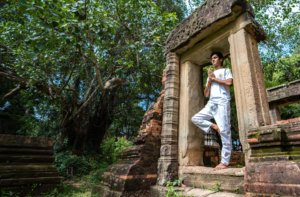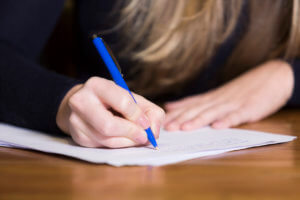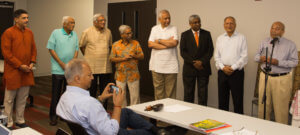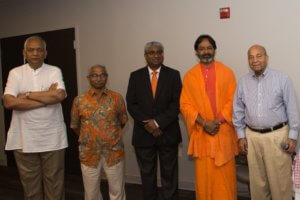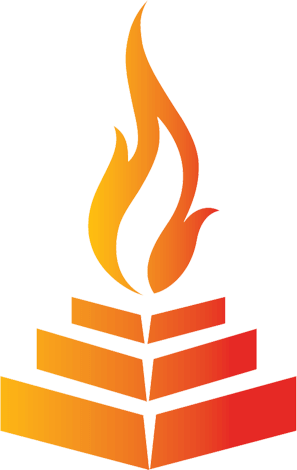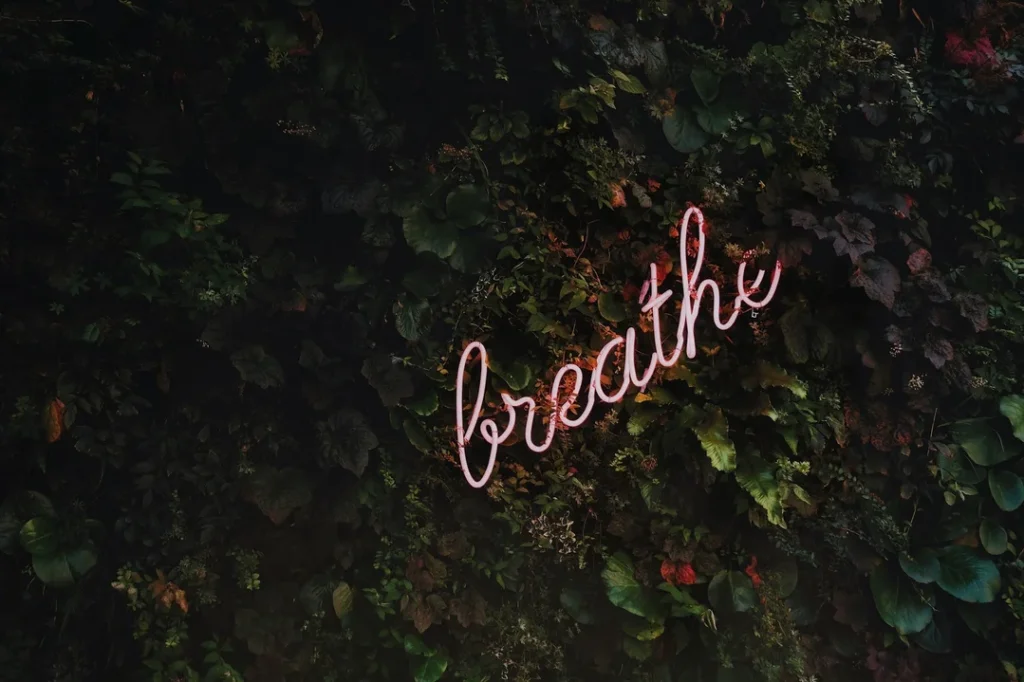
Pranayama is about disciplining the breath, so as to simply be able to follow the prāṇā.
Pranayama
What is the relationship between Hanuman, Garuda and Bhima? Why are they specifically mentioned in the verse that is taught to children in many Indian households, while putting them to bed?
रामं स्कन्दं हनुमंत वैनतेयं वृकोदरम्।
शयनेयस्स्मरेनित्यं दुःस्वप्नस्तस्य नश्यति ।।
They are all related through the vayu tattva: Hanuman is Vayu putra; Bhima is born to Kunti through Vayu ‘s blessing; Garuda, an Eagle, the strongest, most powerful bird, which can reach great heights and see long distances, has mastery over its medium of travel – air. All these characters represent immense power and strength; they are forces of nature.
Hanuman single-handedly took on the entire Lanka when he went there to search for Sita, and then proceeded to causally survey Lanka, and eventually burned it down, striking terror in the hearts of the asuras. He represents the conscious mind which is an amazing tool that humans are blessed with, that has the capability of going into the depths of our darkness and coming out unscathed! He was crucial to the victory of Rama’s, the jiva. Even the Sankhya theory indicates a reference to the mind being born out of the breath. Hanūmān is Vāyu’s son.
Bhima was the only one among the Pandavas, who killed all the ‘evil’ aspects – Bakasura, Jarasandha, Kicaka, and the hundred Kaurava brothers – and literally with his bare hands. He is protective of Draupadi, who is representative of the prana sakti within the breath – the vayu carries the prana sakti. It is because he protects her, that he destroys every asura aspect that disrespects her. So does our breath, with all the aspects within us that harm the sakti within us.
Garuḍa represents an evolved state – fighting Iṇḍra (the senses) and all the other obstacles to obtain the Amrita – the nectar of immortality. However, he did not have any desire to partake of the nectar himself, thus practicing astēya. His only goal was to deliver on his promise to deliver the amruta to the snakes, thus displaying immense integrity by his rootedness in satya. He gained admiration of Śriman Nārāyaṇa Himself with his commitment and mastery over the Yamas! Garuḍa is the vehicle that transports Lord Viśnu and His consort (Love and Abundance). Viśnu is called vāyuvāhana. One can access Viṣṇu and becomes His vehicle simply through their breath!
Pranayama is about disciplining the breath, so as to simply be able to follow the prana. The yoga sutras define pranayama as
तस्मिन् सति श्वासप्रश्वासयोः गतिविच्छेदः प्राणायामः ।।
Having achieved harmony in āsana, prāṇāyama is that which interrupts the erratic/disturbed flow of breath. It brings discipline to the breathing. After having achieved स्थिरम् sthiram and सुखम् sukham in āsana, the yoga practitioner automatically turns towards the breath. They harmonize the breath in the āsana practice and feel it flow with the body movements, with the mind simply observing both the body and the breath. The mind is still being trained to be dependent on both these tangible aspects. When they pause, it pauses. As the practitioner progresses, the mind is trained to become independent of, first, the body – through staying/holding still in the postures while focusing on the inflow and outward flow of the breath. Then the mind is trained to become independent of the breath – through holding of the breath itself, kumbhaka, in various still postures. But since the mind has been initially conditioned to move with the body and breath and stop when they do, it is now able to hold still without the support of the body or the breath. At this point the निरालम्ब nirālaṃba mind is ready for ध्यान dhyāna.
Pranayama, working with the breath, is considered to be the most powerful of the बहिरङ्ग bahiraṅga practices – namely, yama, niyama, āsana, Pranayama and to some extent pratyāhāra, where the senses lose interest in the external attractions and are drawn inward. In reality, all of these practices can become meditative and hence अन्तरङ्ग antaraṅga practices.
The breath is naturally involuntary to begin with. It is part of the parasympathetic system of the human body which controls all the involuntary functions like respiration, digestion, circulation, etc. We have no control over the parasympathetic system, unlike the motor muscles, for example, that we can exercise control over voluntarily. The breath is the only involuntary aspect that we can access, thereby giving us a path into our involuntary inner world. When the breath is rapid, all the systems are in high gear, and just as in a fast race car, systems tend to get worn down easily. When the breath is slowed down, all the systems relax, and ample time is available for exchange of gases, food, waste, rest and repair, and the body works more efficiently. By consciously controlling the breath and slowing it down, we allow the body to work in its most efficient zone.
At a deeper level, prāṇāyama is said to burn up the impurities in the body. That includes the saṃskāras we are born with. When one starts paying attention to the body and breath in their practice, they start observing their own habit patterns of their mind manifest on the body as various imbalances, blocks, tendencies, compulsions, etc. The moment one becomes aware of a pattern, it starts transforming in some way.
When one does the deep breathing in the recommended way, involving the diaphragm to draw the breath in as well as to expel the breath, it is said that the जठराग्नि jaṭharāgni gets involved in the whole process. During the inhalation, the fire is blown by the downward flowing air, towards the मूलाधारचक्र mūlādhāracakra at the base of the spine, and during the exhalation, as the diaphragm pushes upward to expel the air, it pulls the mūlādhāracakra closer to the flame. This process causes three things to happen. First, the breath slows down considerably and reaches deeper. Second, the jaṭharāgni is stoked, which means metabolism, circulation and energy levels improve. The third is something deeper. The mūlādhāracakra is said to contain all the aspects of what makes us who we are. It is the root of the spinal column, along which all our imbalances manifest, and that attracts the imbalanced situations and experiences that we go through – situations that are tailor-made for each one of us because of our make-up. Imagine, situations tailor-made to torture us or to please us, if we allow them to! When we perform yogic practices in the right way, all our tendencies start to become dormant. Yet, there is a possibility that they can arise at any time. Through practice of prāṇāyama, when the seeds of क्लेशाः kleśās in the mūlādhāra are burnt though, those dormant tendencies are vanquished. This takes lifetimes to achieve! (And as a side note, it truly offends me when people who casually practice yoga call themselves yogis!!)
When we achieve that level of mastery over our breath, our asuras (the nocturnal creatures that show up in our bad dreams and nightmares) are vanquished (दुस्स्वप्नस्तस्य नश्यति dussvapnastasya naśyati – bad dreams are destroyed). These are nothing but our own shortcomings, sprouting from the seeds of impurities in our mūlādhāracakra. Thereafter, we are able to breathe in pure Love and Abundance (Lord Viṣṇu and Lakṣmī Devi) carried through us by our breath (our वायु अंश Vāyu amśa – Garuḍa).
Staying with our breath gives us strength, power, commitment and mastery over the Yamas that these Vāyu aspects stand for.
Cover Pic Credit: Tim Goedhart – Unsplash
